How the office was invented
- Published
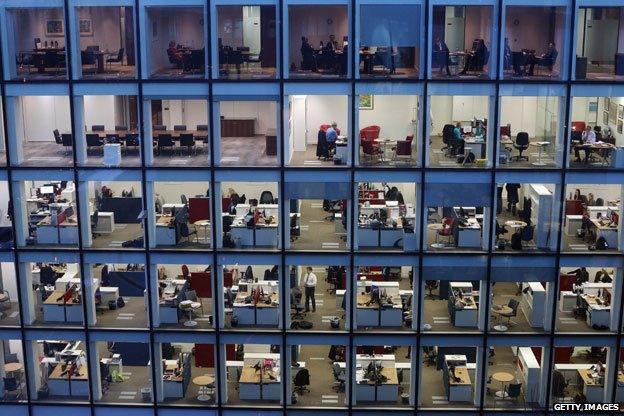
Many people might think of office-bound life as a modern phenomenon, but there's a long history of people chained to their desks, explains Lucy Kellaway.
In medieval London the old St Paul's Cathedral used to dwarf everything around it. Now it is dwarfed - by offices.
The Shard, Canary Wharf, NatWest Tower - offices dominate the skyline.
I imagine archaeologists in the future having a pretty easy time working out what matters to us today. The Egyptians had their pyramids, the Romans had aqueducts, Victorians their railways. What we've got are gigantic glass and steel boxes of desks, whiteboards and water coolers.
The office is where we spend most of our time. It's practically where we live. Our colleagues and our bosses see more of us than our families do.
Everyone loves telling me that this is a bad thing - as the saying goes, "No-one ever said on their deathbed 'I wish I'd spent more time in the office'." But actually it's not quite true.
At least one man - PT Barnum, who gave us the circus - was wishing himself back in the office as he took his last gasp. "How were receipts today at Madison Square gardens?" he said as he croaked.
And, as for the rest of us, office work gives our life structure, purpose and, at a pinch, meaning.
But walk into any office and you can't help but wonder what are they actually doing?
You can tell if a teacher is teaching or a builder building, but with us office workers, the dreams, the ambition, the lust and the extreme boredom is all hidden.
Over the past two centuries, the office has changed everything.
It has made us all middle class. It has transformed a lot of women, who have skipped from kitchen to boardroom, pausing at the typing pool on the way. It has also raised standards in education and been the reason for many technological advances.
But the office itself seems to have no history. We all just seem to accept the way we work now. There's the charade of the annual appraisal. All those grim PowerPoint presentations in interminable meetings. The open plan offices where we overhear colleagues phoning their plumbers. But why? How did we get here?
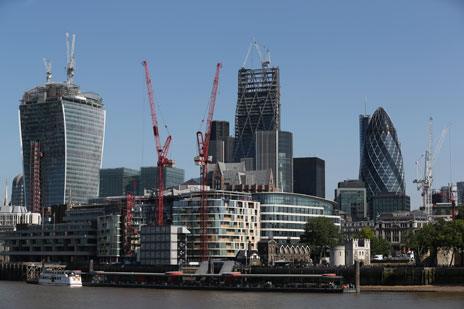
The London skyline - ever more dominated by office buildings
It seems to me that the office today is having a bit of an identity crisis. It's not clear that we even need physical offices anymore when we can work in Starbucks instead.
Everyone says work has taken over their lives, leaving them stressed and good for nothing else. But it's impossible to assess just how bad things are now without having a picture of how they used to be.
In the British Library, which has become something of a modern office with the free wi-fi, coffee and comfy chairs, hangs a portrait of a man who is looking quite enigmatically at the readers coming in. This is Charles Lamb, who wrote one of the best accounts of what it was actually like to be a clerk at the end of the 18th Century. A lot of it sounds rather familiar.
"Thirty years have I served the Philistines, and my neck is not subdued to the yoke. You don't know how wearisome it is to breathe the air of four pent walls without relief day after day."
But what is an office? The best way to think about it is that it's wherever the admin gets done. That means a skyscraper counts, and so - at a pinch - does a Blackberry.
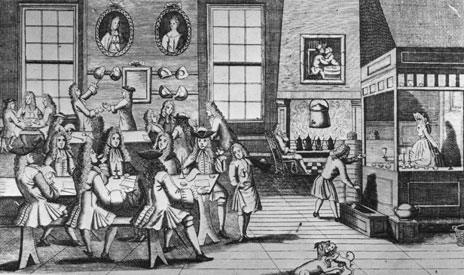
An 18th Century London coffee house
On that definition, coffee shops are included and so, too, people's homes - and it was in these two places in the City of London in the 18th Century that most office work was done.
Owners tended to live above the shop, employing clerks who lived there too and who were treated a bit like domestic servants. The advantage was that there was no commute, the disadvantage was that there was no escape.
The Barings lived and worked in Mincing Lane, and later the Rothschilds lived round the corner in St Swithin's Lane. But just up the road in Leadenhall Street, one of London's first purpose-built offices had its home. Built in 1729, it housed the East India Company.
"The East India Company is hugely significant for the history of offices because it created over time a very large and complex bureaucracy," says Huw Bowen of Swansea University.
"It began its life in 1600 as a trading company managing long distance trade with Asia. That, of course, generated huge volumes of documents. But over time in the mid 18th Century it acquired an empire in India.
"At the company's headquarters they created the bureaucracy to process information and make decisions about things that were taking place thousands of miles away."
It was to East India House that a 17-year-old Charles Lamb went to work in 1792.
Managing an empire at such a great distance created a lot of paperwork and it didn't arrive in your inbox in under a second - mail from India took five to eight months to get there.
But when the boat got in, they were very busy indeed. Lamb wrote:
"On Friday I was at office from 10 in the morning (two hours dinner except) to 11 at night - last night till 9." There was much about Lamb's working life that sounds incredibly familiar. Like the way his employers granted perks one minute, only to take them away again as soon as times got hard.
In 1817, the holiday allowance of £10 a year was cut for new members of staff, Saturday became a full working day and the equivalent of the Christmas office party, the "yearly turtle feast", was scrapped.
Lamb wrote to a colleague John Chambers, who was off work with scurvy, complaining about some of the changes.
"The Committee have formally abolish'd all holydays whatsoever - for which may the Devil, who keeps no holydays, have them in his eternal burning workshop."
In an even more petty policy change, Lamb and his colleagues were made to sign in and out, and every quarter of an hour had to ensure they were in the office.
"This annoyed Dodwell, a fellow-clerk, considerably, for he had to sign six or seven times while reading the newspaper," he added.
"Lamb talks fondly of his colleagues," says Bowen. "It was quite clear that practical jokes took place. There was a social life. A very rich atmosphere in some ways."
But while intellectuals thrived at East India House, others found it very depressing indeed. There are examples of people killing themselves - one worker, Richard Burford, threw himself out of a window in the 1790s.
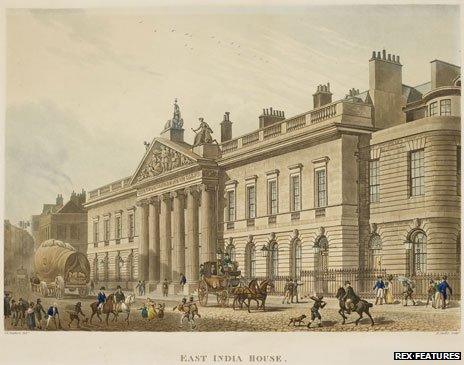
East India House - Charles Lamb's workplace
There is also a lot of evidence of what we would call work-related stress. In those days it was described as being insane.
"[There was the] creative side like Lamb, and these other people who were clerical drones," says Bowen.
"These men must have had a terrible existence. Going in to work day in day out for 40 years, copying out letters and accounts with no prospect of promotion unless somebody ahead of them died."
At the age of 50, Lamb retired on a final salary pension of two thirds of his salary. The transition from work to retirement was a tricky one.
"For the first day or two I felt stunned. I wandered about, thinking I was happy, and knowing that I was not," he wrote.
"I was in the condition of a prisoner in the old Bastile, suddenly let loose after a forty years' confinement."
He later visited his former office and details an experience familiar to anyone who has made the mistake of returning to a place they once worked.
"We cracked some of our old jokes, but methought they went off but faintly. My old desk, the peg where I hung my hat, were appropriated to another. I knew it must be, but I could not take it kindly."
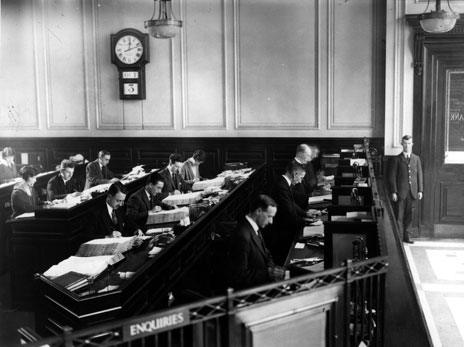
The office - once left, you can never go back
This, surely, is the eternal plight of all of us office workers. We long to escape. But such is its hold on us, that when we do, we leave a part of ourselves behind - a part we never even knew existed.
This piece is based on an edited transcript of Lucy Kellaway's History of Office Life, produced by Russell Finch, of Somethin' Else, for Radio 4. Episode one, The Beginnings of the Modern Office, is broadcast on 22 July, 13:45 BST
Episode two, Getting a Job: Nepotism or Meritocracy?, is broadcast on 23 July, 13:45 BST